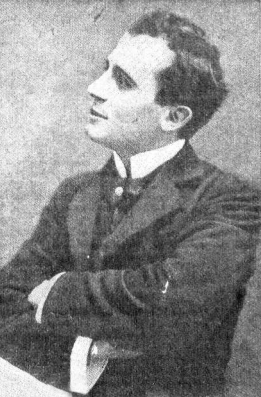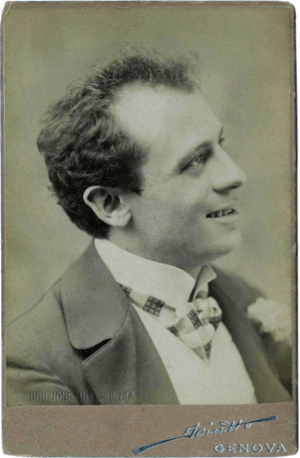Leopoldo Fregoli facts for kids
Leopoldo (Luigi) Fregoli (born July 2, 1867, in Rome – died November 26, 1936, in Viareggio) was a very famous Italian actor. He was known as a stage star and a master of quick changes.
Contents
Master of Quick Changes
Fregoli was considered the best and most flexible quick-change artist of his time. He was famous for his amazing ability to impersonate different people. He could also change roles very quickly.
When he performed in London in the 1890s, some people spread rumors. They thought there was more than one Fregoli on stage. But Fregoli quickly stopped these rumors. He invited journalists and people who doubted him backstage. There, they could watch him work and see his secrets. Fregoli even helped other performers who tried to copy him. He gave them advice on how to get better.
Starting His Career
Fregoli started as an amateur performer. His first steps to becoming a professional happened while he was in the Italian army. This was in Abyssinia in 1890. The general, Antonio Baldissera, had hired a group of actors to entertain his soldiers. But the actors did not show up.
Fregoli offered to perform instead and was an instant hit! General Baldissera then assigned Fregoli to perform at the theater in Massowah. Fregoli became the director and stage manager there. After a year, he went back to Italy. He performed in Rome, Genoa, and Florence.
In Florence, a government clerk named Ugo Biondi saw Fregoli perform. He was so impressed that he asked Fregoli for lessons. Fregoli kindly agreed. Biondi later became another great quick-change artist. At first, he said he was Fregoli's student. But later, he claimed to be the 'original' Fregoli.
Performing in London
From Italy, Fregoli traveled to Brazil, Spain, and the United States. While he was in Madrid, Alfred Moul watched him perform. Moul was the manager of the Alhambra Theatre in London. He had heard about Fregoli's talent. Moul wanted to be the first to sign him for shows in Britain.
Moul said that Fregoli and his helpers were paid £350 per week. This was a huge amount of money back then! But Fregoli brought in even more money from ticket sales.
The Alhambra Theatre was supposed to reopen in March 1897. It would feature a new ballet by Sir Arthur Sullivan. There were some problems with the ballet, as it was too long. So, Fregoli was asked to perform for a week or two. He didn't need many special sets. Fregoli was so successful that the ballet was not performed until late May!
Fregoli became a sensation in London. He did fast-paced shows, impersonating famous musicians like Wagner, Rossini, Verdi, and Paderewski. He would leave the stage as a street musician and quickly reappear as a woman. Everyone, including famous actors, wanted to see him. His shows were extended again and again. More seats were even added to the theater. This was amazing, especially since he didn't even speak English!
People thought he was not just a great quick-change artist. They also saw him as a wonderful actor and a brilliant writer. He performed privately for kings, queens, and rich families. He even calmly explained all his tricks to them. Many people tried to copy him. Soon, every theater in London had its own quick-change artist.
Later Years and Retirement
Fregoli enjoyed his success, but he was a humble man. He didn't want to stay in London forever. In May 1898, he left for Argentina. He promised to return to London the next February.
His biggest success was at the Olympia Theatre in Paris. He performed there for over a year. He kept coming back to Paris until 1910. After that, he toured Italy and South America for many years.
Suddenly, in 1922, he decided to stop performing quick changes. This happened while he was performing in Niterói, a city near Rio de Janeiro.
He returned to Italy. His work later inspired Futurist theater performers. He wrote his own life story, called an autobiography. He is buried in Italy. His gravestone has the words "His last transformation" on it.
Fregoli Delusion
The Fregoli delusion is a rare condition. In this disorder, a person believes that different people are actually one person who changes how they look. This person might think the disguised person is trying to harm them.
Artists Inspired by Fregoli
Many artists have been inspired by Leopoldo Fregoli.
- Arturo Brachetti: This Italian magician and quick-change artist is a modern follower of Fregoli's style. In 1979, he was the first quick-change performer after Fregoli. He created new tricks for changing costumes. He is listed in the Guinness World Records as the fastest and most productive performer in the world. More than 2 million people worldwide have seen his one-man show.
- Ennio Marchetto: This Venetian quick-change artist created his own unique style. All his costumes, wigs, and props are flat and made from cardboard and paper. His costumes change in front of the audience, like origami. He is sometimes called "The Living Cartoon." Ennio has been very successful around the world since 1989.
- Lizzie Ramsden: She was known as 'The Female Fregoli.' She performed in music halls across Britain and America from about 1895 to 1904.
See also
 In Spanish: Leopoldo Fregoli para niños
In Spanish: Leopoldo Fregoli para niños



